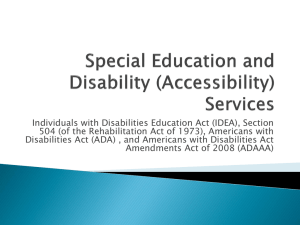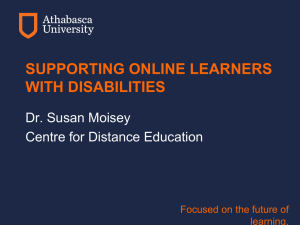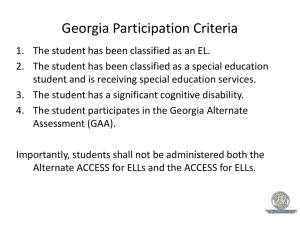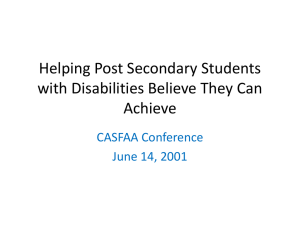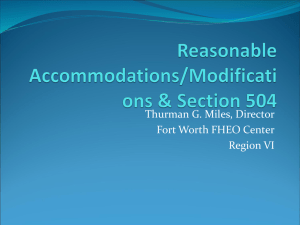Perspectives of Recent College Graduates with Disabilities
advertisement
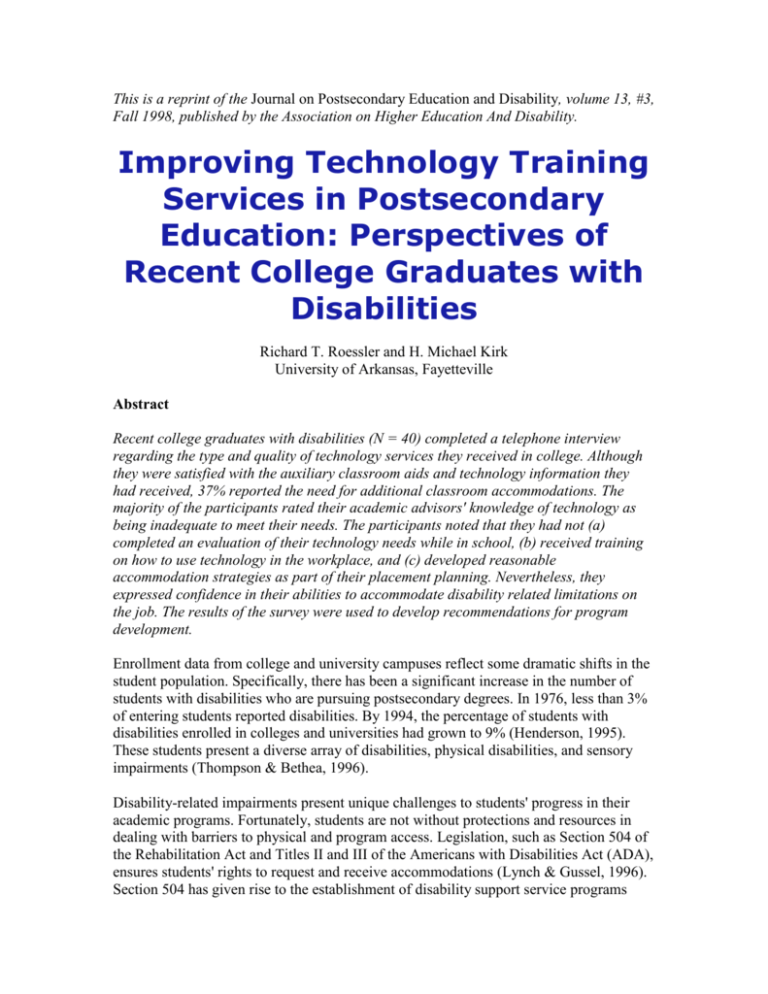
This is a reprint of the Journal on Postsecondary Education and Disability, volume 13, #3, Fall 1998, published by the Association on Higher Education And Disability. Improving Technology Training Services in Postsecondary Education: Perspectives of Recent College Graduates with Disabilities Richard T. Roessler and H. Michael Kirk University of Arkansas, Fayetteville Abstract Recent college graduates with disabilities (N = 40) completed a telephone interview regarding the type and quality of technology services they received in college. Although they were satisfied with the auxiliary classroom aids and technology information they had received, 37% reported the need for additional classroom accommodations. The majority of the participants rated their academic advisors' knowledge of technology as being inadequate to meet their needs. The participants noted that they had not (a) completed an evaluation of their technology needs while in school, (b) received training on how to use technology in the workplace, and (c) developed reasonable accommodation strategies as part of their placement planning. Nevertheless, they expressed confidence in their abilities to accommodate disability related limitations on the job. The results of the survey were used to develop recommendations for program development. Enrollment data from college and university campuses reflect some dramatic shifts in the student population. Specifically, there has been a significant increase in the number of students with disabilities who are pursuing postsecondary degrees. In 1976, less than 3% of entering students reported disabilities. By 1994, the percentage of students with disabilities enrolled in colleges and universities had grown to 9% (Henderson, 1995). These students present a diverse array of disabilities, physical disabilities, and sensory impairments (Thompson & Bethea, 1996). Disability-related impairments present unique challenges to students' progress in their academic programs. Fortunately, students are not without protections and resources in dealing with barriers to physical and program access. Legislation, such as Section 504 of the Rehabilitation Act and Titles II and III of the Americans with Disabilities Act (ADA), ensures students' rights to request and receive accommodations (Lynch & Gussel, 1996). Section 504 has given rise to the establishment of disability support service programs across the United States. Such programs provide significant resources for students. The purpose of these programs is to help colleges and universities make "appropriate academic adjustments and reasonable modifications to policies and practices to allow the full participation of students with disabilities in the same programs and activities available to non-disabled students" (Jarrow, 1991, p. 1). Of course, under the provisions of Section 504 and Title II of the ADA, students must take the initiative to disclose their disability status, provide proper documentation, and request appropriate accommodations. The burden of creating an accommodated educational experience does not fall solely on students with disabilities. Institutions have responsibilities as well. Postsecondary institutions must inform students of their rights and responsibilities. As Torkelson, Lynch, and Gussel (1996) stressed, "Students have the right to nondiscrimination, meaningful access, individualized assessments, effective academic adjustments and aids, and confidentiality" (p. 352). According to Kroeger and Schuck (1993), "effective academic adjustments and aids" include auxiliary supports, such as note-takers and interpreters , as well as assistive technology, such as reading machines and voice activated computers. To date, evidence suggests that auxiliary aids are far more often used as academic accommodations for disability-related limitations than are different types of assistive technology. In a recent survey of disability support service programs, Carroll and Johnson-Bown (1996) found that campus service providers were providing students with disabilities with only minimal assistance in terms of assistive technology. Thompson and Dooley Dickey (1994) further documented the need for critical technology training services for students with disabilities, including orientation to legislative protections, assessment of assistive technology needs, training in the use of assistive technology, and access to aids and devices for classroom use. Based on comments gathered in focus groups with students with disabilities, Coomber (1996) reported specific student concerns about the technology training services. Students with disabilities reported training services. Students with disabilities reported that they were not informed about new technology and its availability. Because of lack of training and support, they believed they were unprepared to benefit from technology. Moreover, they experienced confusion regarding whom to contact for technology assistance on campus, as well as the nature of personal and institutional responsibilities in the accommodation seeking process. The lack of (a) education on civil rights legislation, (b) technology needs assessment, (c) technology training services, and (d) access to assistive technology has ramifications beyond the college years for students with disabilities. Without technology-related information and services during college, students are less likely to succeed in their transition in to the world of work (Satcher, 1995). For example, they may not know what they have the right to request a reasonable accommodation following the job offer and the right to request that employers review their accommodation needs following employment (Thompson & Dooley Dickey, 1994). In addition, they may not have knowledge of the wide range of assistive technology available to them and the proper steps to transfer the use of such technology to the workplace (Rumrill, Gordon, & Roessler, 1993). As Satcher (1995) found, successful college graduates with learning disabilities tended to know about (a) civil rights protections under the ADA, and (b) technology needs and solutions in the workplace. Unfortunately, observers have noted that there is very little research that addresses how students with disabilities cope with these career development needs at the postsecondary lever (Friehe, Aune, & Leuenberger, 1996). Evidence supports the value of increasing students' knowledge of assistive technology and of their rights to request and use such technology in educational and employment settings. Programs such as Career Connections at the University of Minnesota (Aune, Mueller, Johnson, Gaipa, Kiu, & Lorsung, 1995) and Project Career at the University of Arkansas (Rumrill, Roessler, Boen, & Brown, 1995) have informed students of their rights to accommodations in both educational and employment settings, assisted students in analyzing their technology needs and in developing reasonable accommodation plans that apply in both settings, and supervised students in accommodated work experience opportunities in the community . Outcome statistics reported by the Career Connections project reported an 88% employment rate 6 to 12 months after graduation (Aune et al., 1995), an employment rate that compares very favorably with the general employment rate of 66% for college graduates with disabilities (Gingerich, 1996). Assisting students with disabilities with their technology-related needs in college is an important step toward enhancing their success both in school and work. Differences of opinion, however, exist regarding the preferred means of providing such assistance. The debate centers on whether such programs should be provided by specialized support centers, such as those endorsed under Section 504, or by "generic or generally available service" (Enright, Conyers, & Szymanski, 1996). Concern exists that generic service providers may not (a) have the expertise to provide specialized training on assistive technology, (b) be able to facilitate classroom accommodation request procedures, and (c) be knowledgeable about disclosure and accommodation provisions of Title I of the ADA. On the other hand, Jones (1996) and Enright et al. (1996) stress the importance of inclusive service delivery in which faculty, academic advisors, career service counselors, and student affairs personnel provide high quality assistance for students with disabilities. Regardless of the method of service provision, the first step that researchers must take involves gathering information about the comprehensiveness of technology training services currently available to college students with disabilities. Hence, the purpose of this study was to identify the types and quality of technology services received by a group of 40 recent graduates with disabilities from a large state university. Students were also asked to comment on (a) the improvements needed in technology services while in school, (b) their self-perceived knowledge of protections contained in the ADA, and (c) their confidence in their ability to identify and implement accommodations in the workplace. Method Participants Comprised of 40 recent university graduates who had registered for services from the Office of Campus Access (OCA; i.e., they had documented permanent disabilities), the sample consisted primarily of people ranging in age from 24 to 44 (M = 34, SD =10). Most of the participants (77%, n = 31) had received a bachelor's degree from the university. They obtained their degrees in the following academic areas: liberal arts (40%, n = 16), education (35%, n =14), business (17%, n = 7), agriculture and home economics (5%, n = 2), and architecture (2%, n =1). Including 24 women (60%) and 16 men (40%), the sample was predominantly white (92%, n = 37). About one-third (37%, n =15) of the group was married at the time of the interview. Individuals in the sample reported the following types of primary disabilities: physical disabilities (47.5%, n=19), learning disabilities (37.5%, n = 15), sensory disabilities (7.5%, n = 3), emotional disabilities (5%, n = 2), and speech impairment (2.5%, n =1). Sixty percent (n = 24) of the participants were employed, and 5 of the unemployed individuals reported that they were seeking employment. The majority (n = 8) of the remaining 11 unemployed participants were continuing their education. Only one participant reported being unemployed due to disability-related reasons. Instrumentation Telephone interview development. Based on a review of relevant research (Carroll & Johnson-Bown, 1996; Coomber,1996; Tompson & Dooley Dickey, 1994) and their experiences in administering Project Career for college students with disabilities (Roessler, Rumrill, & Brown, 1994), the authors developed a structured telephone interview with questions pertinent to attitudes toward and experiences with technology use and accommodation planning in college. In particular, questions about the quality of technology training services addressed the deficiencies that students with disabilities reported in Coomber's (1996) focus groups, and the need for additional information on ADA Title I provisions documented in Thompson and Dooley Dickey's (1994) research. Interview format. The first section of the interview addressed demographic and disability issues, including information about whether the students were currently employed, in graduate training, or seeking employment. Participants were also asked whether they experienced barriers in securing classroom and employment accommodations. In the second section of the survey, respondents described the nature and quality of technology and accommodation services they received. Students described their perceptions of their academic advisor's help with technology needs, the amount of technology training and learning they experienced while in college, their evaluation of different types of accommodations used in college, and the satisfactoriness of information about their rights and responsibilities under the ADA. The interview closed with questions about participants' satisfaction and self-efficacy levels regarding specific tasks involved in identifying and implementing on-the-job accommodations, a deficiency area that was previously notified by Thompson and Dooley Dickey (1994). Item formats included extensive checklists, open-ended questions with probes, and satisfaction/ adequacy ratings based on a 1-5 scale (5 being the most positive rating). For example, the item "What classroom accommodations did you use while you were a student?" was followed by a checklist including 17 specific accommodations and space to list other accommodations. Respondents answered open-ended questions such as, "Were there technical skills training opportunities that you did not take advantage of that you now wish you had?" Student ratings using the 1 to 5 scale were gathered on such items as "During the time you were a student, how much did you learn about the variety of technology available at the school? (1 - nothing, 5 - everything I needed to know). To improve the validity of the interview, the investigators completed several steps. The OCA director and the program specialist critiqued the questions prior to a pilot test. In the pilot test, 2 interviewers and the senior author interviewed 5 college graduates with disabilities. Based on feedback from these interviewees, the authors made several changes in the interview questions. As a result of the pilot test, the interviewers, 1 master's and 1 doctoral student in rehabilitation, also gained valuable experience in conducting the 1-hour interview. Procedure With assistance from OCA, researchers developed a list of students with disabilities who had graduated after 1991 (N = 688). Because many of these students had temporary impairments while enrolled in school (e.g., a student with a broken leg who used handicapped parking for 6 weeks), they were not eligible to participate in the study. After eliminating individuals with temporary conditions, investigators requested current telephone numbers from the Alumni Office for the remaining graduates. Based on their records, the Alumni Office could provide current address information for 103 possible participants. Telephone contacts were initiated based on a random sequence (derived from the use of a random numbers table). Any individual who could not be contacted in three attempts was dropped from the sample. Following this procedure, 40 graduates who agreed to complete the telephone survey were contacted. Throughout the interview, interviewers encouraged participants to suggest ways to improve technology training and assistance for college students with disabilities. A rater familiar with assistive technology and the needs of college students with disabilities coded free responses, for the most part, by simply listing verbatim responses of the students and then grouping similar statements together. Data Analysis Descriptive summaries of the survey results from the 40 participants with disabilities are reported regarding (a) types of disability-related limitations and accommodations, (b) services received regarding technology needs in college, (c) services received regarding technology needs in employment, and (d) confidence regarding their ability to implement accommodations at work. In some cases, fewer than 40 participants responded to a given item. Therefore, percentages reported are based on a smaller number of responses. Correlations among selected variables were also calculated. Results Types of Disability-Related Limitations and Accommodations The participants described how disability related limitations had affected their performance in college and how accommodations had helped them cope with those problems. Reflecting the diversity of people and disabilities contained in the sample, a number of different barriers and accommodative solutions were noted. Nevertheless, several trends occurred in the symptom and accommodation data. When they were asked to describe performance related areas affected by their disabilities, at least 10% (n > 4) or more of the sample identified the following issues: mobility/walking (35%, n = 14), reading problems (25%, nn =10), taking longer to do work (17%, n = 7), writing (15%, n = 6), fatigue (12%, n = 5), and vision (10%, nn = 4). Consistent with the fact that about 45% (n =18) of the sample reported learning disabilities, frequently used accommodations (i.e., mentioned by four or more of the students) included computer software such as spellchecker (25%, n = 10), tape recorders (17%, n = 7), and taped texts (12%, n = 5). Of those participants specifying that they used accommodations (n = 21), 13 (62%) said they paid for them, 7 (33%) said that OCA paid for them, and one participant reported sharing accommodation costs with OCA. Overall, the participants rated their accommodations as very adequate for meeting classroom needs (M = 4.14, SD =1.19 on a 5-point scale). In an open-ended question about accommodation use, the participants voluntarily described frequently used strategies. Twelve percent or more of the sample had experience with the following: extended time for tests (50%, n = 20), non-distracting testing environment (32%, n = 13), handicapped parking permit (22%, n = 9), note-taker (22%, n = 9), reader (17%, n = 7), recording of lectures (17%, n = 7), scribe (15%, n = 6), reading material on tape (15%, n = 6), and van service (12%, n = 5). Unfortunately, accommodations provided were not always sufficient; 15 of the participants (37%) reported that they needed other accommodations in college. Services Received Regarding Technology Needs in College In their postsecondary education experiences during the early to mid 90's, the vast majority of respondents (92%, n = 37) did not participate in an evaluation of their technology needs. Some of the participants were fortunate in that they found their academic advisors to be very knowledgeable about such issues; however, most did not. On a 5-point rating from not knowledgeable (1) to very knowledgeable (5), the average rating of faculty advisor's knowledge was 2.4 (SD = 1.66). In fact, the majority of the participants who responded to this item (53%, n = 17) believed that their faculty advisors had very little to no knowledge about technology and how it could be used by students with disabilities. The participants were somewhat more positive about what they had learned about technology in college, providing midrange ratings (M = 2.9, SD = 1.3) of how much they had learned. Sixteen of the students (40%) believed that they had learned nothing or very little while 16 (40%) believed that they had learned a great deal or everything they needed to know. Respondents received information about technology throughout their time at the university, and they were satisfied with the quality of the information they received (M = 3.6, SD = 1.14). Gaining information on technology by their own efforts (13%, n = 4), they also used other sources such as OCA (29%, n = 9); students/friends (23%, n = 7); professors (23%, n = 7); and computer course, parents, campus police, and orientation staff (3%, n = 1) respectively. Participants described the general technology skills training that they received in their postsecondary education. The majority of the participants (60%, n = 24) completed introductory training in use of the personal computer, and a significant number (45%, n = 18) learned how to use a word processor program. Other computer-based technology addressed included using info-links (the on-line computer catalog and search engine, 37%, n = 15), spreadsheet programs (35%, n = 14), e-mail (27%, n = 11), presentation software (20%, n = 8), and the internet (15%, n = 6). The vast majority of participants (92%, n = 37) reported that they were introduced to technology that did not meet their needs, although 35% (n =14) of the group believed that they did not take advantage of the training experiences available to them. The most frequent reasons for not taking advantage of technology training were lack of knowledge about such services (17%, n = 7) and limited access to services (15%, n = 6), with 1 to 3 of the respondents noting other reasons such as intimidation, embarrassment, bureaucracy, finances, lack of assistance, and lack of time. In reflecting on their college careers, from 5 to 9 of the respondents had the following advice for current students with disabilities: learn computer skills (22%, n = 9), use OCA (22%, n = 9), make the effort to learn about technology (22%, n = 9), and be persistent (12%, n = 5). Services Received Regarding Technology Needs in Employment While they were students, the respondents reported that they rarely discussed how to apply technology at work with advisors, instructors, or OCA staff. Eighty-seven percent of the sample (n = 34) indicated that they did not receive any training about how to use assistive technology or accommodations in the workplace. Only a few respondents learned how to use (a) computer software applicable to business settings, (b) the overhead instead of the blackboard, and (c) technology from OCA staff or a rehabilitation counselor. Several participants volunteered ideas about how the university could improve technology transfer services (e.g., teach students about the different types of assistive technology used by employees with disabilities and about appropriate ways to communicate one's technology needs to the employer). Just as technology transfer was rarely discussed during college, respondents did not participate in activities to help them plan their approach to securing employment upon graduation. Seventy-five percent of the participants (n = 30) did not receive formal job seeking assistance, and none of the participants developed reasonable accommodation strategies as part of their placement planning. Respondents who had employment plans typically implemented them on their own. Only a few of the participants (n = 4, 10%) had used Career Services or other campus placement agencies in their efforts to secure employment. Confidence in Ability to Make On-the-Job Accommodations Although the results underscore the need for technology training for college students with disabilities, the respondents were quite confident in their abilities to accommodate disability-related limitations on the job (see Table 1 for ratings). On a global satisfaction rating (5 = very satisfied), the average rating of satisfaction with ability to accommodate disabilities at work was 4.03 (SD = 1.13). Similarly, respondents believed that they could cope with a variety of tasks related to implementing accommodations at work. On a 1 - 5 scale (1 = not very sure to 5 = very sure), average ratings ranged from 3.6 to 4.00 on seven different tasks consistent with accommodation seeking recommendations in Title I of the ADA. Participants were most confident in their abilities to identify accommodation needs and evaluate the effectiveness of on-the-job accommodations, and they were least confident in their abilities to communicate directly with their employers (e.g., request that employers review their accommodation needs and negotiate with their employers regarding implementation of accommodations). Using a 1- 5 rating scale, respondents reported a moderate knowledge of the employment provisions in Title I of the ADA (M = 2.92, SD = 1.29). Apparently, this amount of knowledge is sufficient to support their confidence in their accommodation seeking abilities. At the same time, the results suggest that the participants need additional information on their legal rights; this finding is consistent with other research (Stageberg, Fischer, & Barbut, 1996; Thompson & Dooley Dickey, 1994). Intercorrelations Among the Variables Selected relationships among the variables on the technology survey were examined to learn more about factors affecting the participants' confidence and self-efficacy in the accommodation process. The first set of relationships addresses variables related to overall satisfaction with one's ability to accommodate disability on the job. The second set of relationships addresses factors related to students' confidence in their abilities to perform specific tasks involved in identifying and implementing accommodations. Satisfaction with ability to accommodate one's disability on the job. Student ratings on the satisfaction item were positively and significantly correlated (N = 38, p < .05) with confidence ratings on 5 of the 7 accommodation tasks. Students who were more satisfied with their ability to accommodate disability on the job were also more confident that they could identify their accommodation needs (r = .57), request a review with their employer (r = .47), negotiate with the employer in implementing accommodations (r = .34), evaluate the effectiveness of on-the-job accommodations (r = .35), and participate in all phases of the accommodation process (r = .34). Confidence in performing accommodation implementation tasks. The participants' ratings of the level of "technology" knowledge and assistance provided by their faculty advisors had a significant relationship to accommodation self-confidence. Participant ratings of academic advisor knowledge correlated positively and significantly (p < .05) with confidence ratings on five of the seven accommodation tasks, with similar trends on the other two tasks (p < .10). Therefore, program recommendations address the role of the academic advisor as well as other means for improving technology services for students with disabilities. Discussion Program Recommendations The following recommendations about improving the technology training services that postsecondary institutions offer students with disabilities are based on the results of this study. Each of these recommendations is discussed in detail. 1. Conduct systematic evaluations of technology needs of every entering student and on an as needed basis thereafter. Survey respondents reported using a variety of auxiliary classroom aids that proved to be adequate for certain needs. Thirty-seven percent of the sample reported that they needed other accommodations. Moreover, 92% of the sample had not participated in an evaluation of their technology needs. Based on these results, OCA has initiated an assessment (504 Conference) for all entering students (first year and transfer students). This review is a concrete response to the call for individualized assessment contained in Title II of the ADA. Involving the student, academic advisor, and OCA staff experienced in technology assessment, the 504 Conference culminates in a written accommodation plan for the student's upcoming academic year. The student may request a review of this plan on an annual basis. This assessment process contributes to two significant outcomes. It helps students make a smooth transition into college (Enright et al. 1996), and it ensures that students with disabilities at least initially participate in an important technology service (Friehe, Aune, & Leuenberger, 1996). 2. Incorporate more types of assistive technology in students' accommodation plans. Consistent with other findings in the literature (Carroll & Johnson Bown, 1996), the most frequently used types of accommodations cited by participants of this study included auxiliary and, often, non-technological classroom aids, such as extended time for testing, non-distracting testing environment, notetakers, and readers. Respondents rarely reported experience with assistive technology such as voice-activated word processing, closed circuit television, modified keyboards, different types of screen enhancers, and grammar check software that would reduce or remove barriers to academic success. In addition to using resources for assistive technology consultation for students such as the state vocational rehabilitation agency, the Job Accommodation Network, and ABLEDATA (Rubin & Roessler, 1995), postsecondary institutions must develop mechanisms for delivering the services students need to resolve the problems noted in Coomber's (1996) focus groups. They include a lack of awareness regarding how to access and use technology and ongoing support in terms of troubleshooting and upgrading. 3. Involve students with disabilities with academic advisors who take an active role in helping students meet their technology, academic, and career development needs. In this study, the participants rated their academic advisors as inadequate in terms of knowledge of technology and how to apply it in the classroom and workplace. The majority of the participants who responded to the faculty advisors' knowledge item indicated that their academic advisors had little to no information in this area. Hence, students with disabilities need access to more proactive and informed advisors. As noted previously, quality advisement may result from specialized or inclusive service delivery approaches, with the preference being for advisement delivered in the same way for all students. In that vein, Frost (1992) stressed that all students should receive more intensive assistance (i.e., "developmental advising"). For students with disabilities, developmental advisors could perform such tasks as (a) engage students in discussing and resolving barriers to their academic progress; (b) involve them in academic problem solving and decision making; (c) encourage students' use of campus resources; (d) involve them in schedule planning; and (e) show interest in students' academic, career, and outside interests. To implement developmental advising for students with disabilities, academic advisors need training on legislative protections of students' civil rights, disability-related services at the institution, appropriate classroom technologies for students, and the barriers that students with disabilities face in the employment process (Aune et al., 1995; Rhoads, Slate, & Steger, 1994). Academic advisors also need quality advising materials that are updated on a regular basis. The desk reference guide produced by Project PAACS at Mississippi State University provides a good example (Thompson & Bethea, 1996). Quality developmental advising has the potential to contribute to students' selfconfidence in the technology transfer and accommodation request process. 4. Identify students who need more training in information technology and implement strategies to involve them in formal programs offered by the computing center, library, and disability services staff. The participants were only moderately satisfied with what they had learned about technology while they were in college. Significantly, those respondents who had learned about technology reported that the information was of high quality. Nevertheless, 40% of the sample said that they learned little or nothing about technology while in school. The participants mentioned techniques for helping them overcome such deficits (e.g., enroll in computing center classes on word processing, e-mail, and the internet; complete information technology training offered by the library such as info-links; contact formal sources of help such as the disability student service office; and learn about technology by talking with professors, friends, and rehabilitation counselors). To overcome low program participation rates by students with disabilities, other researchers have suggested intensified marketing for the programs, publicity about how the programs relate to high priority student goals such as employment, and better information sharing among campus programs regarding students and their needs (Friehe et al., 1996). 5. Improve technology-related services that help students make the transition from use of technology in the classroom to use of technology in the workplace. Gaps existed in technology-related service delivery for the participants while they were in college. For example, the vast majority of the respondents never participated in an evaluation of the assistive technology or accommodative strategies that would have helped them be more productive in work. They had not received formal assistance in the job seeking process in terms of structuring their job search, incorporating reasonable accommodations in the placement planning process, or following through on the outcomes of their j ob seeking plans. The literature contains examples of university-based programs that provide these enhanced technology transfer and career planning services. For example, the Career Connections Project and Project Career developed programs and materials for involving students with disabilities in technology training, mentoring by successful employees in the student's field of interest, career counseling and case management, accommodated and supervised work experience in the community, support groups, and systematic technology and placement planning seminars (Aune et al., 1995; Rumrill et al., 1995). 6. Determine whether students have the behavioral proficiency to match their selfconfidence in their abilities to request and make on-the-job accommodations. Unlike the students in Thompson and Dooley Dickey's (1994) study, the college graduates in this sample reported surprisingly high levels of self-confidence regarding their abilities to request and secure on-the-job accommodations. While important, high levels of technology transfer and accommodation self-efficacy may be necessary but not sufficient. Several reasons exist for this assertion. In a recent report entitled "ADA Watch-Year One," the National Council on Disability (1993) stressed that the provision of reasonable accommodations for employees with disabilities remained an area of unmet need. Hence, one might assume that many individuals do not actually have the skills to request and implement reasonable accommodations when they are needed. Furthermore the research literature documents the presence of deficiencies in self-advocacy skills among college students with disabilities when they role-play requesting classroom accommodations from instructors (Roessler, Rumrill, & Brown, 1997). Therefore, student personnel professionals should determine whether students could match their confidence with the performances needed to self-advocate for accommodations and provide self-advocacy training for students who demonstrate skill deficiencies. Limitations Recommendations based on these data must be considered with respect to several shortcomings of the study. The small sample was drawn from only one institution of higher learning, and it consisted of people with different types of disabilities who had the need for different types of assistive technology. Because some individuals could not be reached, they were dropped from the sample; this may have biased the results to some degree. Moreover, the pool of participants was comprised solely of graduates with disabilities who maintained a current address and telephone number with the Alumni Office. Although acknowledging that the results are exploratory in nature, we believe that they are consistent with findings from other studies completed in similar settings (e.g., Carroll & Johnson Bown, 1996; Coomber, 1996; Friehe et al., 1996) which support the need for more comprehensive technology training for people with disabilities enrolled in postsecondary education. Further research is needed to determine whether programmatic changes such as those suggested improve technology skills for students with disabilities. Recommendations for Future Research Future research should address the limitations in the current study as well as explore significant implications of the survey data. Specifically, investigations are needed in which the technology survey is administered with a larger random sample of recent college graduates with disabilities representing several postsecondary institutions. In this same vein, studies with undergraduates are needed to determine their satisfaction with current technology training services. Such studies would produce broader insights into issues pertaining to the varieties of technology assessment and transfer services needed, the adequacy of academic advising regarding technology utilization, and the extent of preparation students receive regarding technology utilization in employment. Research is needed to identify effective advisors in order to learn how they acquire and use current information on assistive technology in their work with students. Finally, social skills research is needed to determine whether students can match their high accommodationseeking self-efficacy, as reported in this article, with skill demonstration in role-play and in in-vivo situations. Table 1 Confidence in on-the-job accommodation ability Satisfaction item Satisfaction with ability to accommodate disability on the job M SD 4.03 1.13 Accommodation Self-efficacy Scale: How certain are you that you can ... Identify your employment accommodation needs 4.02 1.21 Request that your employer review your accommodation needs 3.60 1.39 Discuss your needs with your employer in a face-to-face meeting 3.92 1.37 Negotiate with your employer in implementing reasonable accommodations 3.62 1.43 Evaluate the effectiveness of an on-the-job accommodation 4.05 1.01 Keep the employer informed about your ongoing accommodation needs 3.80 1.28 Participate in all aspects of the accommodation process with your employer 3.77 1.31 Rating (1-5, 5 = High) Authors Note Please contact the senior author at the following address for the full text of the technology survey: Department of Rehabilitation, 346 N. West Avenue, University of Arkansas, Fayetteville, AR 72701. About the Authors Richard T. Roessler, Ph.D., CRC, is a university professor of rehabilitation at the University of Arkansas. Roessler is the principal investigator for Project APT, a 3-year transition services grant funded by the Office of Special Education and Rehabilitation Services. H. Michael Kirk, MS, is a doctoral student in the department of rehabilitation at the University of Arkansas. He received his masters in counseling from the University of Memphis and is a graduate assistant with Project APT.
